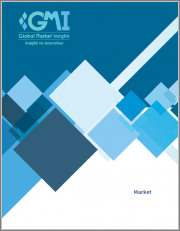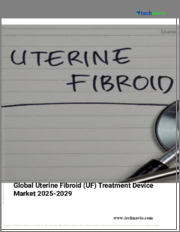
|
시장보고서
상품코드
1368680
자궁근종 치료제 시장 : 약제 클래스별, 유형별, 유통 채널별, 세계 예측(2023-2032년)Uterine Fibroid Treatment Drugs Market - By Drug Class (Progestin-releasing Intrauterine Device, Contraceptive, Gonadotropin-releasing Hormone Antagonist), Type (Submucosal, Intramural), Distribution Channel, Global Forecast, 2023-2032 |
||||||
자궁근종 치료제 시장 규모는 2023-2032년에 CAGR 10%로 대폭적인 성장을 보일 것으로 예상되고 있습니다.
세계에서 자궁근종의 유병률이 증가함에 따라 효과적인 약물 개입에 대한 요구가 증가하고 있습니다.
최근에는 증상을 효과적으로 관리하고 종양 크기를 줄이기 위한 첨단 약물 치료의 개발 및 제공에 대한 관심이 높아지고 있으며, 미국 여성보건국(Office on Women's Health)에 따르면 여성의 20-80%가 50세 이전에 자궁근종을 앓고 있다고 합니다. 이에 따라 자궁근종 환자들의 치료 요구에 대한 관심이 높아지고 있으며, 이에 따라 광범위한 조사 개발 노력이 이루어지고 있습니다. 또한 환자와 의료 전문가들 사이에서 사용 가능한 치료 옵션에 대한 인식이 높아짐에 따라 제품 수요를 촉진하고 있습니다.
자궁근종 치료제 산업은 약품 유형별, 유형별, 유통 채널별, 지역별로 구분됩니다.
약물 유형별로는 성선자극호르몬 방출호르몬 길항제 부문이 2023-2032년 사이에 상당한 성장세를 보일 것으로 예상됩니다. 이는 성선자극호르몬 방출 호르몬(GnRH) 길항제가 비침습적 치료 옵션으로 활용도가 높아지고 있으며, 빠른 증상 완화 및 다량의 월경 출혈을 줄일 수 있는 능력으로 인해 큰 주목을 받고 있기 때문입니다. 우수한 안전성 프로파일과 제한된 부작용과 같은 장점은 이 부문의 성장에 더욱 기여할 것으로 보입니다.
자궁근종 치료제 산업은 병원 유통 채널 부문에서 2022년 상당한 매출을 창출하고 2032년까지 견고한 성장세를 보일 것으로 예상됩니다. 이러한 성장은 효과적인 치료와 환자 결과 개선을 보장하기 위한 병원의 탄탄한 인프라와 환자 치료에 대한 통합적 접근 방식에 기인합니다. 저침습적 시술에 대한 선호도가 높아짐에 따라 병원들은 효과적인 자궁근종 관리를 위해 첨단 제약 솔루션을 채택하고 있습니다.
지역적으로 아시아태평양의 자궁근종 치료제 산업은 의료 인프라 개발의 급증, 자궁근종에 대한 인식 증가, 건강 상태의 유병률 증가에 힘입어 2032년까지 괄목할 만한 성장률을 보일 것으로 예상됩니다. 저침습적 수술의 채택이 증가함에 따라 이 지역에서는 특정 요구에 맞는 새로운 제약 솔루션이 도입되고 있습니다.
또한 효능을 개선하고 부작용을 최소화하기 위한 연구개발이 진행되고 있는 것도 이 지역 시장 전망을 확대할 것으로 보입니다. 일례로 일본 키세이제약은 2022년 7월 자궁근종에 대한 GNRH 길항제 린자고릭스(KLH-2109)의 국내 3상 임상을 개시했습니다.
목차
제1장 조사 방법과 조사 범위
제2장 주요 요약
제3장 자궁근종 치료제 시장 인사이트
- 업계 상황
- 업계에 대한 영향요인
- 촉진요인
- 자궁근종의 유병률 증가
- 자궁근종 여성용 신약의 개발
- 자궁근종에 대한 의식의 향상
- 업계의 잠재적 리스크 & 과제
- 자궁근종 치료제에 수반하는 부작용
- 촉진요인
- 성장 가능성 분석
- COVID-19 영향 분석
- 규제 상황
- Porter의 산업 분석
- PESTEL 분석
제4장 경쟁 구도
- 서론
- 기업 매트릭스 분석
- 경쟁 포지셔닝 매트릭스
- 전략 대시보드
제5장 자궁근종 치료제 시장 추정·예측 : 약제 클래스별
- 주요 동향 : 약제 클래스별
- 황체 호르몬 방출 자궁내 피임기구(IUD) 및 피임약
- 고나도트로핀 방출 호르몬(GnRH) 길항제
- 고나도트로핀 방출 호르몬(GnRH) 작용제
- 비호르몬약
- 기타
제6장 자궁근종 치료제 시장 추정·예측 : 유형별
- 주요 동향 : 유형별
- 점막하 근종
- 경막내 근종
- 장막하 근종
- 유경성 근종
제7장 자궁근종 치료제 시장 추정·예측 : 유통 채널별
- 주요 동향 : 유통 채널별
- 소매 약국
- 병원 약국
- 기타 유통 채널
제8장 자궁근종 치료제 시장 추정·예측 : 지역별
- 주요 동향 : 지역별
- 북미
- 미국
- 캐나다
- 유럽
- 독일
- 영국
- 프랑스
- 스페인
- 이탈리아
- 스위스
- 기타 유럽
- 아시아태평양
- 중국
- 일본
- 인도
- 호주
- 한국
- 기타 아시아태평양
- 라틴아메리카
- 브라질
- 멕시코
- 기타 라틴아메리카
- 중동 및 아프리카
- 남아프리카공화국
- 사우디아라비아
- 기타 중동 및 아프리카
제9장 기업 개요
- Pfizer, Inc.
- Abbvie, Inc.
- AstraZeneca plc
- Bayer AG
- Myovant Sciences Gmbh
- Ferring B.V.
- Amring Pharmaceuticals Inc.
- Theramex
- Watson Pharma, Inc.
Uterine Fibroid Treatment Drugs Market size is set to witness substantial growth at 10% CAGR from 2023-2032. The escalating prevalence of uterine fibroids worldwide is triggering the heightened need for efficacious pharmaceutical interventions.
Of late, there has been growing emphasis on developing and providing advanced drug therapies to effectively manage symptoms and reduce tumor size. According to the Office on Women's Health, between 20% and 80% of women develop fibroids by the age of 50 years. Thus, the higher focus on addressing the therapeutic needs of affected individuals has made way for extensive R&D efforts. Moreover, the surging awareness among patients and healthcare professionals about available treatment options is also bolstering the product demand.
The uterine fibroid treatment drugs industry is segmented into drug class, type, distribution channel, and region.
By drug class, the market share from the gonadotropin-releasing hormone antagonist segment is set to witness considerable growth between 2023 and 2032. This can be attributed to the expanding utilization of gonadotropin-releasing hormone (GnRH) antagonists as viable non-invasive treatment options. With their ability to provide rapid symptomatic relief and alleviate heavy menstrual bleeding, GnRH antagonists are gaining significant prominence. Benefits, such as favorable safety profile and limited side effects will further contribute to the segment growth.
Uterine fibroid treatment drugs industry from the hospital distribution channel segment generated substantial revenue in 2022 and is expected to foresee robust expansion through 2032. The growth can be attributed to the robust infrastructure and integrated approach to patient care in hospitals for ensuring effective treatment and improved patient outcomes. With the growing preference for minimally invasive procedures, hospitals are also increasingly adopting advanced pharmaceutical solutions for effective fibroid management.
Regionally, the Asia Pacific uterine fibroid treatment drugs industry is projected to depict notable growth rate through 2032 fueled by the upsurge in healthcare infrastructure development, increasing awareness about uterine fibroids, and the rising prevalence of the health condition. The growing adoption of minimally invasive procedures has led to the introduction of novel pharmaceutical solutions tailored for specific needs in the region.
Moreover, the ongoing research and development activities aimed at enhancing the efficacy and minimizing adverse effects will augment the regional market outlook. To cite an instance, in July 2022, Japan-based Kissei Pharmaceutical Co., Ltd. began a Japanese Phase III clinical study for the GNRH antagonist linzagolix (KLH-2109) in uterine fibroids.
Table of Contents
Chapter 1 Methodology & Scope
- 1.1 Market definition
- 1.2 Base estimates & calculations
- 1.3 Forecast calculation
- 1.4 Covid-19 impact analysis at global level
- 1.5 Data validation
- 1.6 Data sources
- 1.6.1 Secondary
- 1.6.1.1 Paid sources
- 1.6.1.2 Public sources
- 1.6.2 Primary
- 1.6.1 Secondary
Chapter 2 Executive Summary
- 2.1 Uterine fibroid treatment drugs industry 360 degree synopsis, 2018 - 2032 (USD Million)
- 2.1.1 Business trends
- 2.1.2 Region trends
- 2.1.3 Drug class trends
- 2.1.4 Type trends
- 2.1.5 Distribution channel trends
Chapter 3 Uterine Fibroid Treatment Drugs Market Insights
- 3.1 Industry landscape, 2018 - 2032 (USD Million)
- 3.2 Industry impact forces
- 3.2.1 Growth drivers
- 3.2.1.1 Increasing prevalence of uterine fibroid
- 3.2.1.2 Development of new drugs for women with uterine fibroids
- 3.2.1.3 Growing awareness about uterine fibroids
- 3.2.2 Industry pitfalls & challenges
- 3.2.2.1 Adverse effects associated with uterine fibroid treatment drugs
- 3.2.1 Growth drivers
- 3.3 Growth potential analysis
- 3.3.1 By drug class
- 3.3.2 By type
- 3.3.3 By distribution channel
- 3.4 COVID-19 impact analysis
- 3.5 Regulatory landscape
- 3.6 Porter's analysis
- 3.7 PESTEL analysis
Chapter 4 Competitive Landscape, 2022
- 4.1 Introduction
- 4.2 Company matrix analysis, 2022
- 4.3 Competitive positioning matrix, 2022
- 4.4 Strategic dashboard, 2022
Chapter 5 Uterine Fibroid Treatment Drugs Market Estimates and Forecast, By Drug Class (USD Million)
- 5.1 Key trends, by drug class
- 5.2 Progestin-releasing intrauterine device (IUD) & contraceptives
- 5.3 Gonadotropin-releasing hormone (GnRH) antagonists
- 5.4 Gonadotropin-releasing hormone (GnRH) agonists
- 5.5 Non-hormonal medications
- 5.6 Other drug classes
Chapter 6 Uterine Fibroid Treatment Drugs Market Estimates and Forecast, By Type (USD Million)
- 6.1 Key trends, by type
- 6.2 Submucosal fibroids
- 6.3 Intramural fibroids
- 6.4 Subserosal fibroids
- 6.5 Pedunculated fibroids
Chapter 7 Uterine Fibroid Treatment Drugs Market Estimates and Forecast, By Distribution Channel (USD Million)
- 7.1 Key trends, by distribution channel
- 7.2 Retail pharmacies
- 7.3 Hospital pharmacies
- 7.4 Other distribution channels
Chapter 8 Uterine Fibroid Treatment Drugs Market Estimates and Forecast, By Region (USD Million)
- 8.1 Key trends, by region
- 8.2 North America
- 8.2.1 U.S.
- 8.2.2 Canada
- 8.3 Europe
- 8.3.1 Germany
- 8.3.2 UK
- 8.3.3 France
- 8.3.4 Spain
- 8.3.5 Italy
- 8.3.6 Switzerland
- 8.3.7 Rest of Europe
- 8.4 Asia Pacific
- 8.4.1 China
- 8.4.2 Japan
- 8.4.3 India
- 8.4.4 Australia
- 8.4.5 South Korea
- 8.4.6 Rest of Asia Pacific
- 8.5 Latin America
- 8.5.1 Brazil
- 8.5.2 Mexico
- 8.5.3 Rest of Latin America
- 8.6 Middle East & Africa
- 8.6.1 South Africa
- 8.6.2 Saudi Arabia
- 8.6.3 Rest of Middle East & Africa
Chapter 9 Company Profiles
- 9.1 Pfizer, Inc.
- 9.2 Abbvie, Inc.
- 9.3 AstraZeneca plc
- 9.4 Bayer AG
- 9.5 Myovant Sciences Gmbh
- 9.6 Ferring B.V.
- 9.7 Amring Pharmaceuticals Inc.
- 9.8 Theramex
- 9.9 Watson Pharma, Inc.



















